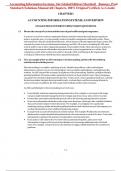Exam (elaborations)
Accounting Information Systems, 14e (Global Edition) Marshall Romney, Paul Steinbart (Solutions Manual All Chapters, 100% Original Verified, A+ Grade)
Accounting Information Systems, 14e (Global Edition) Marshall Romney, Paul Steinbart (Solutions Manual All Chapters, 100% Original Verified, A+ Grade)
[Show more]



